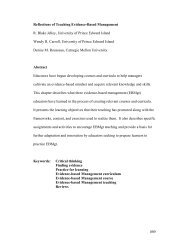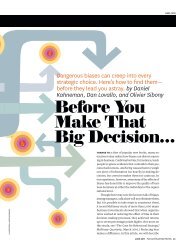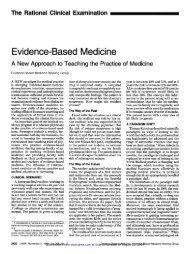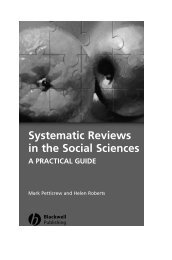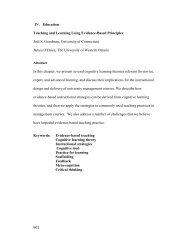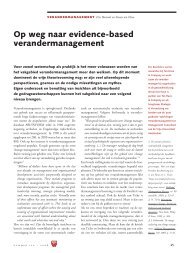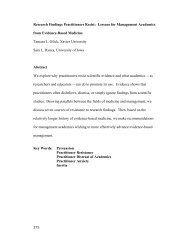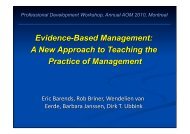Does the inclusion of grey literature influence estimates of ...
Does the inclusion of grey literature influence estimates of ...
Does the inclusion of grey literature influence estimates of ...
You also want an ePaper? Increase the reach of your titles
YUMPU automatically turns print PDFs into web optimized ePapers that Google loves.
ARTICLES<br />
MA level (n=33)<br />
Number <strong>of</strong> RCTs per MA (median [IQR]) 10 (6–19)<br />
Number <strong>of</strong> patients per MA (median [IQR]) 1463 (1120–3163)<br />
Clinical area (frequency)<br />
Gastrointestinal 24·2%<br />
Cardiac 21·2%<br />
Infection 12·1%<br />
Reproduction 12·1%<br />
Circulatory 9·1%<br />
Number <strong>of</strong> sources <strong>of</strong> <strong>grey</strong> <strong>literature</strong> per MA (median [IQR]) 1 (1–2)<br />
Number <strong>of</strong> <strong>grey</strong> items per MA (median [IQR]) 2 (1–3)<br />
Year <strong>of</strong> publication <strong>of</strong> MA (median [IQR]) 1993 (1991–1994)<br />
Interventon comparisons<br />
Published MA with one comparison 27<br />
Published MA with two independent comparisons 4<br />
Published MA with three independent comparisons 2<br />
MA=meta-analysis. RCT=randomised clinical trial.<br />
Table 1: General characteristics <strong>of</strong> meta-analyses<br />
The main outcome was defined as <strong>the</strong> one stated as<br />
such by <strong>the</strong> investigators, or if <strong>the</strong>re was no such<br />
statement, <strong>the</strong> most clinically relevant was used (mortality<br />
would be selected over morbidity); if no outcome was<br />
clinically relevant, <strong>the</strong>n <strong>the</strong> one contributing <strong>the</strong> most<br />
patients was used. 5<br />
Data analyses<br />
We replicated <strong>the</strong> published meta-analyses as a qualitycontrol<br />
measure. After completing <strong>the</strong> replication, each<br />
meta-analyses was repeated with all <strong>grey</strong> items removed,<br />
which allowed us to examine <strong>the</strong> effect <strong>of</strong> <strong>grey</strong> <strong>literature</strong><br />
on <strong>estimates</strong> <strong>of</strong> <strong>the</strong> intervention effect. By <strong>the</strong> use <strong>of</strong> a<br />
logistic-regression model, <strong>the</strong> log odds <strong>of</strong> unwanted events<br />
experienced by each treatment group were related to trial,<br />
intervention, meta-analysis, and <strong>grey</strong> <strong>literature</strong>.<br />
Differences in <strong>the</strong> intervention effect across <strong>the</strong> metaanalyses<br />
were accounted for by an interaction effect<br />
between intervention and meta-analysis. An interaction<br />
term between <strong>grey</strong> <strong>literature</strong> and intervention was<br />
included to capture <strong>the</strong> potential that <strong>grey</strong> <strong>literature</strong> could<br />
modify <strong>estimates</strong> <strong>of</strong> intervention effectiveness. This effect<br />
was expressed as a ratio <strong>of</strong> intervention effect odds ratios<br />
(ie, ratio <strong>of</strong> odds ratios [ROR]) between <strong>grey</strong> and<br />
published <strong>literature</strong>. 6,7 With this modelling convention, an<br />
odds ratio less than 1·0 showed that <strong>the</strong> intervention was<br />
more effective than <strong>the</strong> control in preventing an unwanted<br />
event. Consequently, an ROR between <strong>grey</strong> and<br />
published <strong>literature</strong> greater than 1·0 indicated that, on<br />
average, <strong>estimates</strong> <strong>of</strong> intervention effectiveness from <strong>grey</strong><br />
<strong>literature</strong> were smaller than <strong>the</strong>ir corresponding <strong>estimates</strong><br />
from published work. The results from <strong>the</strong> unconditional<br />
models described above were verified by a conditional<br />
logistic-regression approach (not reported). We also<br />
completed a sensitivity analysis—we assessed <strong>the</strong> potential<br />
effect <strong>of</strong> abstracts as <strong>the</strong> source <strong>of</strong> <strong>grey</strong> <strong>literature</strong>, relative<br />
to published <strong>literature</strong>.<br />
Standard residual diagnostics were used to assess <strong>the</strong><br />
model’s goodness <strong>of</strong> fit. ROR and its 95% CIs were<br />
derived from <strong>the</strong> fitted model. To assess <strong>the</strong> impact <strong>of</strong><br />
<strong>grey</strong> <strong>literature</strong> on <strong>the</strong> variable “no intervention effect”,<br />
Z scores were derived (ie, intervention effect size divided<br />
by its SE) from a meta-analysis with and without <strong>grey</strong><br />
<strong>literature</strong>. The Z scores were <strong>the</strong>n compared statistically<br />
by paired t test. The conditional logistic-regression<br />
analyses (data not reported) were done in LogXact, all<br />
o<strong>the</strong>r analyses in S-Plus 2000.<br />
Results<br />
From <strong>the</strong> original 135 meta-analyses retrieved, we could<br />
not establish whe<strong>the</strong>r <strong>grey</strong> <strong>literature</strong> was included in 12<br />
cases (11 poorly referenced, one not retrieved). An<br />
additional eight meta-analyses were excluded because<br />
<strong>the</strong>y did not fit <strong>the</strong> definition <strong>of</strong> a meta-analysis. Of <strong>the</strong><br />
remaining 115, 38 (33%) were found to contain at least<br />
one item <strong>of</strong> <strong>grey</strong> <strong>literature</strong>. Five <strong>of</strong> <strong>the</strong>se meta-analyses<br />
failed to meet <strong>the</strong> <strong>inclusion</strong> criteria. For all subsequent<br />
investigations, we used <strong>the</strong> sample <strong>of</strong> 33 publications,<br />
contributing 41 separate and independent meta-analyses<br />
(table 1).<br />
When included, <strong>grey</strong> <strong>literature</strong> accounted for between<br />
4·5% and 75% (median=25% [interquartile range=<br />
16·7–33·3%]) <strong>of</strong> <strong>the</strong> studies in a meta-analysis. For <strong>the</strong><br />
sample as a whole, <strong>grey</strong> <strong>literature</strong> contributed 22% (102<br />
<strong>of</strong> 467) <strong>of</strong> <strong>the</strong> studies and 10·7% (23 286 <strong>of</strong> 217 427) <strong>of</strong><br />
<strong>the</strong> participants (table 2). Grey-<strong>literature</strong> studies tended<br />
to be smaller than published ones. None <strong>of</strong> <strong>the</strong> meta-<br />
RCT level<br />
Overall Grey Published<br />
Total number <strong>of</strong> RCTs 467 102 365<br />
Total number <strong>of</strong> patients 217 427 23 286 194 141<br />
Number <strong>of</strong> patients per RCT (median [IQR]) 106 (55–223) 83·5 (48–190) 113 (59–228)<br />
Number with null or negative results 157 (34·6%) 32 (32·0%) 125 (35·3%)<br />
Year <strong>of</strong> publication* (median [IQR]) 1988 (1985–1990) 1989 (1986–1990) 1988 (1984–1990)<br />
Language <strong>of</strong> publication<br />
English 439 (94·0%) 99 (97·1%) 340 (93·2%)<br />
French 11 (2·4%) 2 (2·0%) 9 (2·5%)<br />
German 9 (2·0%) 0 9 (2·5%)<br />
Spanish 4 (0·9%) 1 (1·0%) 3 (0·8%)<br />
Italian 3 (0·7%) 0 3 (0·8%)<br />
Japanese 1 (0·2%) 0 1 (0·3%)<br />
Frequency <strong>of</strong> <strong>grey</strong> sources<br />
Abstracts & symposia 62%<br />
Unpublished 17%<br />
Book chapters 6%<br />
Reports 5%<br />
Pharmaceutical companies 3%<br />
In press 3%<br />
Letters 2%<br />
Theses 2%<br />
RCT=randomised clinical trial. *Publication indicates a prepared report for all <strong>grey</strong> items.<br />
Table 2: General characteristics <strong>of</strong> randomised trials included in <strong>the</strong> meta-analyses<br />
THE LANCET • Vol 356 • October 7, 2000 1229<br />
For personal use only. Not to be reproduced without permission <strong>of</strong> The Lancet.



